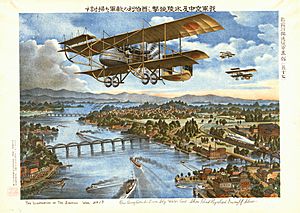Siberian Intervention facts for kids
Quick facts for kids Siberian Intervention |
|||||||
|---|---|---|---|---|---|---|---|
 Japanese lithograph depicting the capture of Blagoveschensk |
|||||||
|
|||||||
| Belligerents | |||||||
|
Entente Powers Supported by: |
|
||||||
| Commanders and leaders | |||||||
| Strength | |||||||
| 70,000 Japanese, 7,950 U.S soldiers, 2,400 Italian troops 1,500 British, 4,192 Canadian, 800 French, 300,000 Kolchakists, 100,000 Semyonov troops, 50,000 bandits total: 550,000 troops |
At least 600,000 | ||||||
| Casualties and losses | |||||||
| 200,000 | 400,000 | ||||||
The Siberian Intervention (1918-1922) was a military action. Several countries, including Japan and Western powers, sent soldiers to Siberia. Their main goal was to help the White Russians. These White Russians were fighting against the Bolshevik Red Army during the Russian Civil War. Most Allied forces left by 1920. However, the Imperial Japanese Army stayed in Siberia until 1922. European soldiers mostly went to the Russian Maritime Provinces.
Contents
Why Did the Siberian Intervention Happen?
The Russian Revolution and World War I
The Siberian Intervention began soon after the Russian October Revolution of 1917. A new group called the Bolsheviks took control of Russia. They signed a peace treaty with Germany. This treaty ended Russia's fighting in World War I.
This was a big problem for the Allied powers (like Britain and France). Germany could now move its soldiers from the eastern front to the western front. This meant more German soldiers would fight against Europe. The peace treaty also allowed Germany to get supplies from Russian ports.
The Czech Legion's Fight for Freedom
Another issue was a group of about 50,000 soldiers called the Czech Legion. They had been fighting with the Allies. After Russia left the war, they became trapped in Russia. The Czechs wanted to fight their way east to Vladivostok. From there, they hoped to sail around the world to rejoin the war in Europe.
They planned to use the Trans-Siberian Railway. But the Bolsheviks controlled this railway. This made their journey very difficult and dangerous.
Allied Goals in Russia
Because of these problems, Great Britain and France decided to get involved in the Russian Civil War. They had three main goals:
- Stop Germany or the Bolsheviks from getting Allied war supplies in Russia.
- Rescue the Czech Legion and help them return to the European front.
- Help create a White Russian government to restart the Eastern Front against Germany.
The British and French did not have enough soldiers. So, they asked the United States for help.
Which Countries Sent Soldiers?
United States Joins the Fight
President Wilson of the United States agreed to help in July 1918. The U.S. sent two groups of soldiers. About 5,000 soldiers went to North Russia. Another 10,000 soldiers, called the American Expeditionary Force Siberia, went to Siberia.
This force was led by Major General William S. Graves. It had 7,950 officers and soldiers at its largest.
China's Role in the Intervention
In the same month, the Russian White movement asked the Beiyang government of the Republic of China to send troops. China sent 2,000 soldiers by August. Later, Chinese forces also occupied parts of Outer Mongolia and Tuva. They even sent a small group to fight against the Bolsheviks in North Russia.
Britain's Small Contribution
The British sent only 1,500 troops to Siberia. These soldiers came from two different regiments.
Canada's Expeditionary Force
The Canadian Siberian Expeditionary Force had 4,192 soldiers. Major General James H. Elmsley led them. They arrived in Vladivostok to support the other Allied armies.
The Canadian soldiers did not do much fighting. Most of them stayed in Vladivostok. They practiced their military skills and helped keep order in the port city. A small group of about 100 Canadians went to Omsk. They worked as support staff for British troops helping the White Russian government. The Canadian troops returned home between April and June 1919.
Italy's Involvement
Italian soldiers were active in three main areas. These were Irkutsk, Harbin, and Vladivostok.
Allied Military Actions (1918-1919)
The Allied countries began working together in Siberia in August 1918. The Japanese army entered through Vladivostok and areas near the Manchurian border. They sent a very large force of over 70,000 soldiers. The Allies worried about Japan's goals because of this large number of troops.
On September 5, the Japanese met the first group of the Czech Legion. A few days later, British, Italian, and French groups joined the Czechs. They tried to restart the war in the east. They wanted to create a new battle line beyond the Ural Mountains. This meant the European allies moved west.
The Japanese, however, had their own plans. They would not go west of Lake Baikal. They stayed behind, and the Americans also stayed to watch the Japanese. By November, the Japanese controlled all major ports and towns in the Russian Maritime Provinces. They also controlled areas in Siberia east of the city of Chita.
During the summer of 1918, the Japanese army supported White Russian groups. The Japanese 5th infantry division and a Japanese-backed group took control of Transbaikalia. They tried to set up a White Russian government there, but it did not last long.
Images for kids
See also
 In Spanish: Intervención en Siberia para niños
In Spanish: Intervención en Siberia para niños





